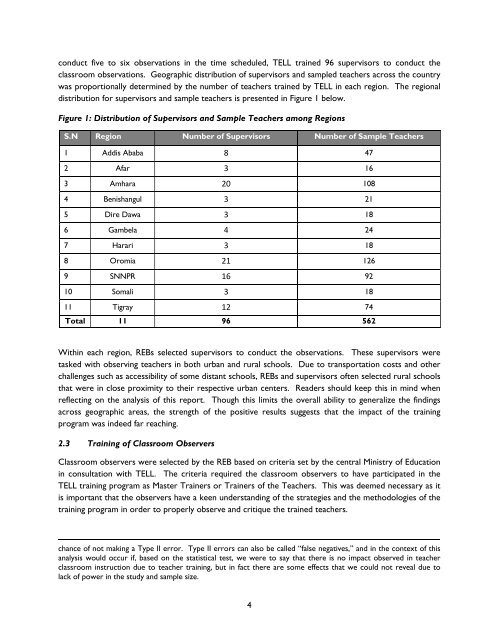2010 Classroom Observation Activity Data Analysis ... - EQUIP123.net
2010 Classroom Observation Activity Data Analysis ... - EQUIP123.net
2010 Classroom Observation Activity Data Analysis ... - EQUIP123.net
You also want an ePaper? Increase the reach of your titles
YUMPU automatically turns print PDFs into web optimized ePapers that Google loves.
conduct five to six observations in the time scheduled, TELL trained 96 supervisors to conduct theclassroom observations. Geographic distribution of supervisors and sampled teachers across the countrywas proportionally determined by the number of teachers trained by TELL in each region. The regionaldistribution for supervisors and sample teachers is presented in Figure 1 below.Figure 1: Distribution of Supervisors and Sample Teachers among RegionsS.N Region Number of Supervisors Number of Sample Teachers1 Addis Ababa 8 472 Afar 3 163 Amhara 20 1084 Benishangul 3 215 Dire Dawa 3 186 Gambela 4 247 Harari 3 188 Oromia 21 1269 SNNPR 16 9210 Somali 3 1811 Tigray 12 74Total 11 96 562Within each region, REBs selected supervisors to conduct the observations. These supervisors weretasked with observing teachers in both urban and rural schools. Due to transportation costs and otherchallenges such as accessibility of some distant schools, REBs and supervisors often selected rural schoolsthat were in close proximity to their respective urban centers. Readers should keep this in mind whenreflecting on the analysis of this report. Though this limits the overall ability to generalize the findingsacross geographic areas, the strength of the positive results suggests that the impact of the trainingprogram was indeed far reaching.2.3 Training of <strong>Classroom</strong> Observers<strong>Classroom</strong> observers were selected by the REB based on criteria set by the central Ministry of Educationin consultation with TELL. The criteria required the classroom observers to have participated in theTELL training program as Master Trainers or Trainers of the Teachers. This was deemed necessary as itis important that the observers have a keen understanding of the strategies and the methodologies of thetraining program in order to properly observe and critique the trained teachers.chance of not making a Type II error. Type II errors can also be called “false negatives,” and in the context of thisanalysis would occur if, based on the statistical test, we were to say that there is no impact observed in teacherclassroom instruction due to teacher training, but in fact there are some effects that we could not reveal due tolack of power in the study and sample size.4
















